Polymeric Microneedles Enhance Transdermal Delivery of Therapeutics
Abstract
:1. Introduction
2. Materials and Methods
2.1. Materials
2.2. Hydrogel Preparation
2.3. Hydrogel Characterization
2.4. Microneedle Fabrication
2.5. Skin Preparation
2.6. Ultrastructural Evaluation
2.7. Chemical Characterization
2.8. Mechanical Analysis
2.9. Dye Binding Studies
2.10. Histological Analysis
2.11. Microchannel Uniformity
2.12. Microchannel Depth
2.13. Skin Integrity Evaluation
- RS denotes the electrical resistance of the skin (kΩ/sq·cm).
- The voltage reduction across the tissue, as measured by the multimeter, is indicated by VS (mV).
- VO represents the fixed circuit voltage at 100 mV.
- RL reflects the load resistance at 100 kΩ.
- A indicates the permeation area of a Franz diffusion cells.
2.14. Permeation Studies
2.15. Skin Disposition Studies
2.16. Statistical Evaluation
3. Results and Discussion
3.1. Hydrogel Characterization
3.2. Ultrastructural Evaluation
3.3. Chemical Characterization
3.4. Mechanical Analysis
3.5. Dye Binding Studies
3.6. Histological Analysis
3.7. Microchannel Uniformity
3.8. Microchannel Depth
3.9. Skin Integrity Evaluation
3.10. Permeation Studies
3.11. Skin Disposition Studies
4. Conclusions
Author Contributions
Funding
Institutional Review Board Statement
Informed Consent Statement
Data Availability Statement
Conflicts of Interest
Abbreviations
| FTIR | Fourier-Transform Infrared Spectroscopy |
| MTX | Methotrexate |
| PBS | Phosphate-Buffered Saline |
| PPI | Pore Permeability Index |
| RP-HPLC | Reversed-Phase High-Performance Liquid Chromatography |
| SD | Standard Deviation |
| SEM | Scanning Electron Microscopy |
| TEWL | Transepidermal Water Loss |
References
- Prasad, R.; Koul, V. Transdermal Delivery of Methotrexate: Past, Present and Future Prospects. Ther. Deliv. 2012, 3, 315–325. [Google Scholar] [CrossRef] [PubMed]
- Abla, M.J.; Chaturvedula, A.; O’Mahony, C.; Banga, A.K. Transdermal Delivery of Methotrexate for Pediatrics Using Silicon Microneedles. Ther. Deliv. 2013, 4, 543–551. [Google Scholar] [CrossRef] [PubMed]
- Bajaj, S.; Whiteman, A.; Brandner, B. Transdermal Drug Delivery in Pain Management. Contin. Educ. Anaesth. Crit. Care Pain 2011, 11, 39–43. [Google Scholar] [CrossRef]
- Cevc, G.; Vierl, U. Nanotechnology and the Transdermal Route: A State of the Art Review and Critical Appraisal. J. Control. Release 2010, 141, 277–299. [Google Scholar] [CrossRef] [PubMed]
- Prausnitz, M.R.; Langer, R. Transdermal Drug Delivery. Nat. Biotechnol. 2008, 26, 1261–1268. [Google Scholar] [CrossRef]
- Tuan-Mahmood, T.-M.; McCrudden, M.T.; Torrisi, B.M.; McAlister, E.; Garland, M.J.; Singh, T.R.R.; Donnelly, R.F. Microneedles for Intradermal and Transdermal Drug Delivery. Eur. J. Pharm. Sci. 2013, 50, 623–637. [Google Scholar] [CrossRef] [PubMed]
- Park, J.-H.; Allen, M.G.; Prausnitz, M.R. Biodegradable Polymer Microneedles: Fabrication, Mechanics and Transdermal Drug Delivery. J. Control. Release 2005, 104, 51–66. [Google Scholar] [CrossRef]
- Nguyen, H.X.; Banga, A.K. Fabrication, Characterization and Application of Sugar Microneedles for Transdermal Drug Delivery. Ther. Deliv. 2017, 8, 249–264. [Google Scholar] [CrossRef] [PubMed]
- Nguyen, H.X.; Bozorg, B.D.; Kim, Y.; Wieber, A.; Birk, G.; Lubda, D.; Banga, A.K. Poly (Vinyl Alcohol) Microneedles: Fabrication, Characterization, and Application for Transdermal Drug Delivery of Doxorubicin. Eur. J. Pharm. Biopharm. 2018, 129, 88–103. [Google Scholar] [CrossRef]
- Tas, C.; Joyce, J.C.; Nguyen, H.X.; Eangoor, P.; Knaack, J.S.; Banga, A.K.; Prausnitz, M.R. Dihydroergotamine Mesylate-Loaded Dissolving Microneedle Patch Made of Polyvinylpyrrolidone for Management of Acute Migraine Therapy. J. Control. Release 2017, 268, 159–165. [Google Scholar] [CrossRef]
- Nguyen, H.X.; Banga, A.K. Delivery of Methotrexate and Characterization of Skin Treated by Fabricated PLGA Microneedles and Fractional Ablative Laser. Pharm. Res. 2018, 35, 68. [Google Scholar] [CrossRef] [PubMed]
- Nguyen, H.; Banga, A. Electrically and Ultrasonically Enhanced Transdermal Delivery of Methotrexate. Pharmaceutics 2018, 10, 117. [Google Scholar] [CrossRef] [PubMed]
- Vora, D.; Garimella, H.T.; German, C.L.; Banga, A.K. Microneedle and Iontophoresis Mediated Delivery of Methotrexate into and across Healthy and Psoriatic Skin. Int. J. Pharm. 2022, 618, 121693. [Google Scholar] [CrossRef] [PubMed]
- Stagni, G.; Shukla, C. Pharmacokinetics of Methotrexate in Rabbit Skin and Plasma after Iv-Bolus and Iontophoretic Administrations. J. Control. Release 2003, 93, 283–292. [Google Scholar] [CrossRef] [PubMed]
- Tian, H.; Cronstein, B.N. Understanding the Mechanisms of Action of Methotrexate. Bull. NYU Hosp. Jt Dis. 2007, 65, 168–173. [Google Scholar]
- Vemulapalli, V.; Yang, Y.; Friden, P.M.; Banga, A.K. Synergistic Effect of Iontophoresis and Soluble Microneedles for Transdermal Delivery of Methotrexate. J. Pharm. Pharmacol. 2008, 60, 27–33. [Google Scholar] [CrossRef] [PubMed]
- Rosenberg, P.; Urwitz, H.; Johannesson, A.; Ros, A.-M.; Lindholm, J.; Kinnman, N.; Hultcrantz, R. Psoriasis Patients with Diabetes Type 2 Are at High Risk of Developing Liver Fibrosis during Methotrexate Treatment. J. Hepatol. 2007, 46, 1111–1118. [Google Scholar] [CrossRef] [PubMed]
- Kaur, J.; Zambito, J.; Richardson, C.T. Methotrexate Injection Site Reactions: Case Report and Literature Review. JAAD Case Rep. 2022, 23, 79–82. [Google Scholar] [CrossRef]
- Zhao, P.; Li, Z.; Ling, Z.; Zheng, Y.; Chang, H. Efficient Loading and Sustained Delivery of Methotrexate Using a Tip-Swellable Microneedle Array Patch for Psoriasis Treatment. ACS Biomater. Sci. Eng. 2024, 10, 921–931. [Google Scholar] [CrossRef]
- Choonhakarn, C.; Chaowattanapanit, S.; Julanon, N.; Limpawattana, P. Comparison of the Clinical Efficacy of Subcutaneous vs. Oral Administration of Methotrexate in Patients with Psoriasis Vulgaris: A Randomized Controlled Trial. Clin. Exp. Dermatol. 2022, 47, 942–948. [Google Scholar] [CrossRef]
- Edwards, C.; Shah, S.A.; Gebhardt, T.; Jewell, C.M. Exploiting Unique Features of Microneedles to Modulate Immunity. Adv. Mater. Deerfield Beach Fla 2023, 35, e2302410. [Google Scholar] [CrossRef] [PubMed]
- Greb, J.E.; Goldminz, A.M.; Elder, J.T.; Lebwohl, M.G.; Gladman, D.D.; Wu, J.J.; Mehta, N.N.; Finlay, A.Y.; Gottlieb, A.B. Psoriasis. Nat. Rev. Dis. Primer 2016, 2, 16082. [Google Scholar] [CrossRef]
- Aickara, D.; Bashyam, A.M.; Pichardo, R.O.; Feldman, S.R. Topical Methotrexate in Dermatology: A Review of the Literature. J. Dermatol. Treat. 2022, 33, 512–517. [Google Scholar] [CrossRef] [PubMed]
- Javadzadeh, Y.; Hamishehkar, H. Enhancing Percutaneous Delivery of Methotrexate Using Different Types of Surfactants. Colloids Surf. B Biointerfaces 2011, 82, 422–426. [Google Scholar] [CrossRef] [PubMed]
- Lee, W.-R.; Shen, S.-C.; Fang, C.-L.; Zhuo, R.-Z.; Fang, J.-Y. Topical Delivery of Methotrexate via Skin Pretreated with Physical Enhancement Techniques: Low-Fluence Erbium: YAG Laser and Electroporation. Lasers Surg. Med. 2008, 40, 468–476. [Google Scholar] [CrossRef] [PubMed]
- Alvarez-Figueroa, M.J.; Delgado-Charro, M.B.; Blanco-Mendez, J. Passive and Iontophoretic Transdermal Penetration of Methotrexate. Int. J. Pharm. 2001, 212, 101–107. [Google Scholar] [CrossRef]
- Kumar, B.; Sandhu, K.; Kaur, I. Topical 0.25% Methotrexate Gel in a Hydrogel Base for Palmoplantar Psoriasis. J. Dermatol. 2004, 31, 798–801. [Google Scholar] [CrossRef] [PubMed]
- Alvarez-Figueroa, M.J.; Blanco-Mendez, J. Transdermal Delivery of Methotrexate: Iontophoretic Delivery from Hydrogels and Passive Delivery from Microemulsions. Int. J. Pharm. 2001, 215, 57–65. [Google Scholar] [CrossRef]
- Ali, M.F.M.; Salah, M.; Rafea, M.; Saleh, N. Liposomal Methotrexate Hydrogel for Treatment of Localized Psoriasis: Preparation, Characterization and Laser Targeting. Med. Sci. Monit. 2008, 14, PI66–PI74. [Google Scholar]
- Sutton, L.; Swinehart, J.M.; Cato, A.; Kaplan, A.S. A Clinical Study to Determine the Efficacy and Safety of 1% Methotrexate/Azone®(MAZ) Gel Applied Topically Once Daily in Patients with Psoriasis Vulgaris. Int. J. Dermatol. 2001, 40, 464–467. [Google Scholar] [CrossRef]
- Prasad, R.; Anand, S.; Koul, V. Biophysical Assessment of DC Iontophoresis and Current Density on Transdermal Permeation of Methotrexate. Int. J. Pharm. Investig. 2011, 1, 234–239. [Google Scholar] [CrossRef]
- Taudorf, E.H.; Lerche, C.M.; Vissing, A.-C.; Philipsen, P.A.; Hannibal, J.; D’Alvise, J.; Hansen, S.H.; Janfelt, C.; Paasch, U.; Anderson, R.R.; et al. Topically Applied Methotrexate Is Rapidly Delivered into Skin by Fractional Laser Ablation. Expert Opin. Drug Deliv. 2015, 12, 1059–1069. [Google Scholar] [CrossRef] [PubMed]
- Donnelly, R.F.; Prausnitz, M.R. The Promise of Microneedle Technologies for Drug Delivery. Drug Deliv. Transl. Res. 2024, 14, 573–580. [Google Scholar] [CrossRef] [PubMed]
- Abd-El-Azim, H.; Abbas, H.; El Sayed, N.; Mousa, M.R.; Elbardisy, H.M.; Zewail, M. Hypericin Emulsomes Combined with Hollow Microneedles as a Non-Invasive Photodynamic Platform for Rheumatoid Arthritis Treatment. Int. J. Pharm. 2024, 653, 123876. [Google Scholar] [CrossRef] [PubMed]
- Le, Z.; Yu, J.; Quek, Y.J.; Bai, B.; Li, X.; Shou, Y.; Myint, B.; Xu, C.; Tay, A. Design Principles of Microneedles for Drug Delivery and Sampling Applications. Mater. Today 2023, 63, 137–169. [Google Scholar] [CrossRef]
- Bauleth-Ramos, T.; El-Sayed, N.; Fontana, F.; Lobita, M.; Shahbazi, M.-A.; Santos, H.A. Recent Approaches for Enhancing the Performance of Dissolving Microneedles in Drug Delivery Applications. Mater. Today 2023, 63, 239–287. [Google Scholar] [CrossRef]
- Chen, B.; Wei, J.; Iliescu, C. Sonophoretic Enhanced Microneedles Array (SEMA)—Improving the Efficiency of Transdermal Drug Delivery. Sens. Actuators B Chem. 2010, 145, 54–60. [Google Scholar] [CrossRef]
- Amarnani, R.; Shende, P. Microneedles in Diagnostic, Treatment and Theranostics: An Advancement in Minimally-Invasive Delivery System. Biomed. Microdevices 2021, 24, 4. [Google Scholar] [CrossRef] [PubMed]
- Gowda, B.H.J.; Ahmed, M.G.; Hani, U.; Kesharwani, P.; Wahab, S.; Paul, K. Microneedles as a Momentous Platform for Psoriasis Therapy and Diagnosis: A State-of-the-Art Review. Int. J. Pharm. 2023, 632, 122591. [Google Scholar] [CrossRef]
- Du, H.; Yang, J.; Li, M.; Xia, Y.; Li, Y.; Zhu, J.; Zhang, L.; Tao, J. Microneedle-Assisted Percutaneous Delivery of Methotrexate-Loaded Nanoparticles Enabling Sustained Anti-Inflammatory Effects in Psoriasis Therapy. J. Mater. Chem. B 2024, 12, 2618–2627. [Google Scholar] [CrossRef]
- Dai, P.; Ge, X.; Sun, C.; Jiang, H.; Zuo, W.; Wu, P.; Liu, C.; Deng, S.; Yang, J.; Dai, J.; et al. A Novel Methacryloyl Chitosan Hydrogel Microneedles Patch with Sustainable Drug Release Property for Effective Treatment of Psoriasis. Macromol. Biosci. 2023, 23, e2300194. [Google Scholar] [CrossRef] [PubMed]
- Rajendran, K.; Pahal, S.; Badnikar, K.; Nayak, M.M.; Subramanyam, D.N.; Vemula, P.K.; Krishnan, U.M. Methotrexate Delivering Microneedle Patches for Improved Therapeutic Efficacy in Treatment of Rheumatoid Arthritis. Int. J. Pharm. 2023, 642, 123184. [Google Scholar] [CrossRef] [PubMed]
- Zhao, W.; Zheng, L.; Yang, J.; Ma, Z.; Tao, X.; Wang, Q. Dissolving Microneedle Patch-Assisted Transdermal Delivery of Methotrexate Improve the Therapeutic Efficacy of Rheumatoid Arthritis. Drug Deliv. 2023, 30, 121–132. [Google Scholar] [CrossRef] [PubMed]
- Lü, J.-M.; Wang, X.; Marin-Muller, C.; Wang, H.; Lin, P.H.; Yao, Q.; Chen, C. Current Advances in Research and Clinical Applications of PLGA-Based Nanotechnology. Expert Rev. Mol. Diagn. 2009, 9, 325–341. [Google Scholar] [CrossRef] [PubMed]
- Lagreca, E.; Onesto, V.; Di Natale, C.; La Manna, S.; Netti, P.A.; Vecchione, R. Recent Advances in the Formulation of PLGA Microparticles for Controlled Drug Delivery. Prog. Biomater. 2020, 9, 153–174. [Google Scholar] [CrossRef] [PubMed]
- Cunha, A.; Gaubert, A.; Latxague, L.; Dehay, B. PLGA-Based Nanoparticles for Neuroprotective Drug Delivery in Neurodegenerative Diseases. Pharmaceutics 2021, 13, 1042. [Google Scholar] [CrossRef] [PubMed]
- Mansoor, S.; Kondiah, P.P.D.; Choonara, Y.E.; Pillay, V. Polymer-Based Nanoparticle Strategies for Insulin Delivery. Polymers 2019, 11, 1380. [Google Scholar] [CrossRef] [PubMed]
- Malek-Khatabi, A.; Sadat Razavi, M.; Abdollahi, A.; Rahimzadeghan, M.; Moammeri, F.; Sheikhi, M.; Tavakoli, M.; Rad-Malekshahi, M.; Faraji Rad, Z. Recent Progress in PLGA-Based Microneedle-Mediated Transdermal Drug and Vaccine Delivery. Biomater. Sci. 2023, 11, 5390–5409. [Google Scholar] [CrossRef]
- Kim, M.; Jung, B.; Park, J.-H. Hydrogel Swelling as a Trigger to Release Biodegradable Polymer Microneedles in Skin. Biomaterials 2012, 33, 668–678. [Google Scholar] [CrossRef]
- Panda, A.; Sharma, P.K.; McCann, T.; Bloomekatz, J.; Repka, M.A.; Murthy, S.N. Fabrication and Development of Controlled Release PLGA Microneedles for Macromolecular Delivery Using FITC-Dextran as Model Molecule. J. Drug Deliv. Sci. Technol. 2022, 68, 102712. [Google Scholar] [CrossRef]
- Loizidou, E.Z.; Inoue, N.T.; Ashton-Barnett, J.; Barrow, D.A.; Allender, C.J. Evaluation of Geometrical Effects of Microneedles on Skin Penetration by CT Scan and Finite Element Analysis. Eur. J. Pharm. Biopharm. 2016, 107, 1–6. [Google Scholar] [CrossRef] [PubMed]
- Ambrose, C.G.; Clanton, T.O. Bioabsorbable Implants: Review of Clinical Experience in Orthopedic Surgery. Ann. Biomed. Eng. 2004, 32, 171–177. [Google Scholar] [CrossRef] [PubMed]
- Nguyen, H.X.; Banga, A.K. Enhanced Skin Delivery of Vismodegib by Microneedle Treatment. Drug Deliv. Transl. Res. 2015, 5, 407–423. [Google Scholar] [CrossRef]
- Kolli, C.S.; Banga, A.K. Characterization of Solid Maltose Microneedles and Their Use for Transdermal Delivery. Pharm. Res. 2008, 25, 104–113. [Google Scholar] [CrossRef]
- Kalluri, H.; Kolli, C.S.; Banga, A.K. Characterization of Microchannels Created by Metal Microneedles: Formation and Closure. AAPS J. 2011, 13, 473–481. [Google Scholar] [CrossRef]
- Zhao, J.; Ji, L.; Wang, H.; Chen, Z.-Q.; Zhang, Y.-T.; Liu, Y.; Feng, N.-P. Microemulsion-Based Novel Transdermal Delivery System of Tetramethylpyrazine: Preparation and Evaluation in Vitro and in Vivo. Int. J. Nanomed. 2011, 6, 1611. [Google Scholar]
- Lapteva, M.; del Río-Sancho, S.; Wu, E.; Carbonell, W.S.; Böhler, C.; Kalia, Y.N. Fractional Laser Ablation for the Targeted Cutaneous Delivery of an Anti-CD29 Monoclonal Antibody–OS2966. Sci. Rep. 2019, 9, 1030. [Google Scholar] [CrossRef]
- del Río-Sancho, S.; Lapteva, M.; Sonaje, K.; Böhler, C.; Ling, V.; Boehncke, W.-H.; Kalia, Y.N. Targeted Cutaneous Delivery of Etanercept Using Er: YAG Fractional Laser Ablation. Int. J. Pharm. 2020, 580, 119234. [Google Scholar] [CrossRef]
- Stumpp, O.; Chen, B.; Welch, A.J. Using Sandpaper for Noninvasive Transepidermal Optical Skin Clearing Agent Delivery. J. Biomed. Opt. 2006, 11, 041118. [Google Scholar] [CrossRef]
- Miyano, T.; Tobinaga, Y.; Kanno, T.; Matsuzaki, Y.; Takeda, H.; Wakui, M.; Hanada, K. Sugar Micro Needles as Transdermic Drug Delivery System. Biomed. Microdevices 2005, 7, 185–188. [Google Scholar] [CrossRef]
- Caspers, P.J.; Bruining, H.A.; Puppels, G.J.; Lucassen, G.W.; Carter, E.A. In Vivo Confocal Raman Microspectroscopy of the Skin: Noninvasive Determination of Molecular Concentration Profiles. J. Investig. Dermatol. 2001, 116, 434–442. [Google Scholar] [CrossRef] [PubMed]
- Donnelly, R.F.; Singh, T.R.R.; Tunney, M.M.; Morrow, D.I.J.; McCarron, P.A.; O’Mahony, C.; Woolfson, A.D. Microneedle Arrays Allow Lower Microbial Penetration than Hypodermic Needles in Vitro. Pharm. Res. 2009, 26, 2513–2522. [Google Scholar] [CrossRef]
- Groves, R.B.; Coulman, S.A.; Birchall, J.C.; Evans, S.L. Quantifying the Mechanical Properties of Human Skin to Optimise Future Microneedle Device Design. Comput. Methods Biomech. Biomed. Engin. 2012, 15, 73–82. [Google Scholar] [CrossRef]
- Li, G.; Badkar, A.; Kalluri, H.; Banga, A.K. Microchannels Created by Sugar and Metal Microneedles: Characterization by Microscopy, Macromolecular Flux and Other Techniques. J. Pharm. Sci. 2010, 99, 1931–1941. [Google Scholar] [CrossRef]
- Kim, Y.-C.; Park, J.-H.; Prausnitz, M.R. Microneedles for Drug and Vaccine Delivery. Adv. Drug Deliv. Rev. 2012, 64, 1547–1568. [Google Scholar] [CrossRef] [PubMed]
- Kalluri, H.; Banga, A.K. Formation and Closure of Microchannels in Skin Following Microporation. Pharm. Res. 2011, 28, 82–94. [Google Scholar] [CrossRef] [PubMed]
- Chereddy, K.K.; Coco, R.; Memvanga, P.B.; Ucakar, B.; des Rieux, A.; Vandermeulen, G.; Préat, V. Combined Effect of PLGA and Curcumin on Wound Healing Activity. J. Control. Release 2013, 171, 208–215. [Google Scholar] [CrossRef]
- Singh, G.; Kaur, T.; Kaur, R.; Kaur, A. Recent Biomedical Applications and Patents on Biodegradable Polymer-PLGA. Int J Pharmacol. Pharm. Sci. 2014, 1, 30–42. [Google Scholar]
- Lee, J.W.; Park, J.-H.; Prausnitz, M.R. Dissolving Microneedles for Transdermal Drug Delivery. Biomaterials 2008, 29, 2113–2124. [Google Scholar] [CrossRef]
- Loizidou, E.Z.; Williams, N.A.; Barrow, D.A.; Eaton, M.J.; McCrory, J.; Evans, S.L.; Allender, C.J. Structural Characterisation and Transdermal Delivery Studies on Sugar Microneedles: Experimental and Finite Element Modelling Analyses. Eur. J. Pharm. Biopharm. 2015, 89, 224–231. [Google Scholar] [CrossRef]
- Muniz, E.C.; Geuskens, G. Polyacrylamide Hydrogels and Semi-Interpenetrating Networks (IPNs) with Poly (N-Isopropylacrylamide): Mechanical Properties by Measure of Compressive Elastic Modulus. J. Mater. Sci. Mater. Med. 2001, 12, 879–881. [Google Scholar] [CrossRef] [PubMed]
- Davis, S.P.; Landis, B.J.; Adams, Z.H.; Allen, M.G.; Prausnitz, M.R. Insertion of Microneedles into Skin: Measurement and Prediction of Insertion Force and Needle Fracture Force. J. Biomech. 2004, 37, 1155–1163. [Google Scholar] [CrossRef] [PubMed]
- Donnelly, R.F.; Garland, M.J.; Morrow, D.I.; Migalska, K.; Singh, T.R.R.; Majithiya, R.; Woolfson, A.D. Optical Coherence Tomography Is a Valuable Tool in the Study of the Effects of Microneedle Geometry on Skin Penetration Characteristics and In-Skin Dissolution. J. Control. Release 2010, 147, 333–341. [Google Scholar] [CrossRef] [PubMed]
- Olatunji, O.; Das, D.B.; Garland, M.J.; Belaid, L.; Donnelly, R.F. Influence of Array Interspacing on the Force Required for Successful Microneedle Skin Penetration: Theoretical and Practical Approaches. J. Pharm. Sci. 2013, 102, 1209–1221. [Google Scholar] [CrossRef] [PubMed]
- van der Maaden, K.; Varypataki, E.M.; Yu, H.; Romeijn, S.; Jiskoot, W.; Bouwstra, J. Parameter Optimization toward Optimal Microneedle-Based Dermal Vaccination. Eur. J. Pharm. Sci. 2014, 64, 18–25. [Google Scholar] [CrossRef]
- Vemulapalli, V.; Bai, Y.; Kalluri, H.; Herwadkar, A.; Kim, H.; Davis, S.P.; Friden, P.M.; Banga, A.K. In Vivo Iontophoretic Delivery of Salmon Calcitonin Across Microporated Skin. J. Pharm. Sci. 2012, 101, 2861–2869. [Google Scholar] [CrossRef] [PubMed]
- Bal, S.M.; Kruithof, A.C.; Zwier, R.; Dietz, E.; Bouwstra, J.A.; Lademann, J.; Meinke, M.C. Influence of Microneedle Shape on the Transport of a Fluorescent Dye into Human Skin in Vivo. J. Control. Release 2010, 147, 218–224. [Google Scholar] [CrossRef] [PubMed]
- Coulman, S.A.; Birchall, J.C.; Alex, A.; Pearton, M.; Hofer, B.; O’Mahony, C.; Drexler, W.; Považay, B. In Vivo, in Situ Imaging of Microneedle Insertion into the Skin of Human Volunteers Using Optical Coherence Tomography. Pharm. Res. 2011, 28, 66–81. [Google Scholar] [CrossRef]
- Enfield, J.; O’Connell, M.-L.; Lawlor, K.; Jonathan, E.; O’Mahony, C.; Leahy, M. In-Vivo Dynamic Characterization of Microneedle Skin Penetration Using Optical Coherence Tomography. J. Biomed. Opt. 2010, 15, 046001. [Google Scholar] [CrossRef]
- Oh, J.-H.; Park, H.-H.; Do, K.-Y.; Han, M.; Hyun, D.-H.; Kim, C.-G.; Kim, C.-H.; Lee, S.S.; Hwang, S.-J.; Shin, S.-C.; et al. Influence of the Delivery Systems Using a Microneedle Array on the Permeation of a Hydrophilic Molecule, Calcein. Eur. J. Pharm. Biopharm. 2008, 69, 1040–1045. [Google Scholar] [CrossRef]
- Yan, G.; Warner, K.S.; Zhang, J.; Sharma, S.; Gale, B.K. Evaluation Needle Length and Density of Microneedle Arrays in the Pretreatment of Skin for Transdermal Drug Delivery. Int. J. Pharm. 2010, 391, 7–12. [Google Scholar] [CrossRef] [PubMed]
- Al-Qallaf, B.; Das, D.B. Optimizing Microneedle Arrays to Increase Skin Permeability for Transdermal Drug Delivery. Ann. N. Y. Acad. Sci. 2009, 1161, 83–94. [Google Scholar] [CrossRef] [PubMed]
- Römgens, A.M.; Bader, D.L.; Bouwstra, J.A.; Baaijens, F.P.T.; Oomens, C.W.J. Monitoring the Penetration Process of Single Microneedles with Varying Tip Diameters. J. Mech. Behav. Biomed. Mater. 2014, 40, 397–405. [Google Scholar] [CrossRef] [PubMed]
- Teo, M.A.L.; Shearwood, C.; Ng, K.C.; Lu, J.; Moochhala, S. In Vitro and in Vivo Characterization of MEMS Microneedles. Biomed. Microdevices 2005, 7, 47–52. [Google Scholar] [CrossRef]
- Kochhar, J.S.; Quek, T.C.; Soon, W.J.; Choi, J.; Zou, S.; Kang, L. Effect of Microneedle Geometry and Supporting Substrate on Microneedle Array Penetration into Skin. J. Pharm. Sci. 2013, 102, 4100–4108. [Google Scholar] [CrossRef] [PubMed]
- Sivaraman, A.; Banga, A.K. Novel in Situ Forming Hydrogel Microneedles for Transdermal Drug Delivery. Drug Deliv. Transl. Res. 2017, 7, 16–26. [Google Scholar] [CrossRef] [PubMed]
- Vemulapalli, V.; Banga, A.K.; Friden, P.M. Optimization of Iontophoretic Parameters for the Transdermal Delivery of Methotrexate. Drug Deliv. 2008, 15, 437–442. [Google Scholar] [CrossRef] [PubMed]
- Shah, U.U.; Roberts, M.; Orlu Gul, M.; Tuleu, C.; Beresford, M.W. Needle-Free and Microneedle Drug Delivery in Children: A Case for Disease-Modifying Antirheumatic Drugs (DMARDs). Int. J. Pharm. 2011, 416, 1–11. [Google Scholar] [CrossRef] [PubMed]
- Iqbal, M.P.; Baig, J.A.; Ali, A.A.; Niazi, S.K.; Mehboobali, N.; Hussain, M.A. The Effects of Non-Steroidal Anti-Inflammatory Drugs on the Disposition of Methotrexate in Patients with Rheumatoid Arthritis. Biopharm. Drug Dispos. 1998, 19, 163–167. [Google Scholar] [CrossRef]
- Ramanan, A.V.; Campbell-Webster, N.; Ota, S.; Parker, S.; Tran, D.; Tyrrell, P.N.; Cameron, B.; Spiegel, L.; Schneider, R.; Laxer, R.M.; et al. The Effectiveness of Treating Juvenile Dermatomyositis with Methotrexate and Aggressively Tapered Corticosteroids. Arthritis Rheum. 2005, 52, 3570–3578. [Google Scholar] [CrossRef]
- Bjerring, P.; Beck, H.I.; Zachariae, H.; Søgaard, H. Topical Treatment of Psoriatic Skin with Methotrexate Cream: A Clinical, Pharmacokinetic, and Histological Study. Acta Derm. Venereol. 1986, 66, 515–519. [Google Scholar] [CrossRef] [PubMed]
- Weinstein, G.D.; McCullough, J.L.; Olsen, E. Topical Methotrexate Therapy for Psoriasis. Arch. Dermatol. 1989, 125, 227–230. [Google Scholar] [CrossRef] [PubMed]




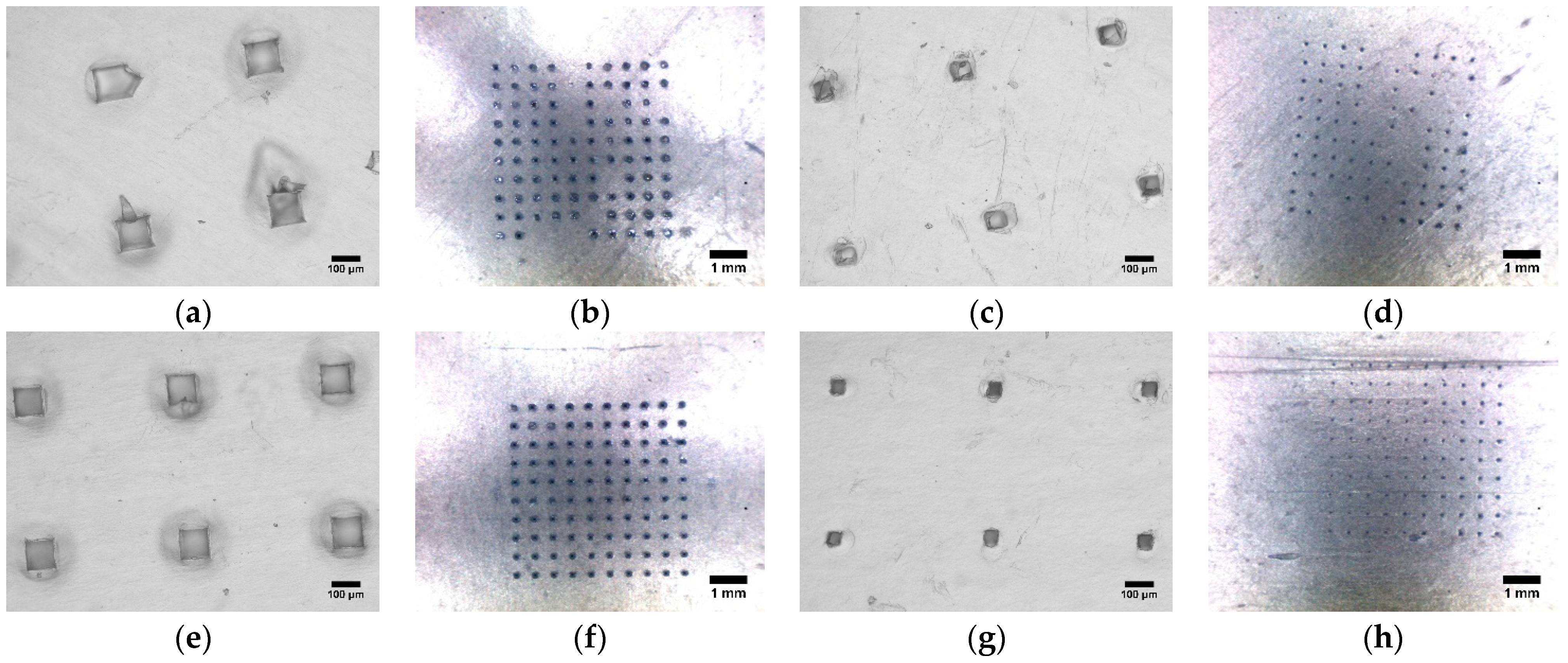

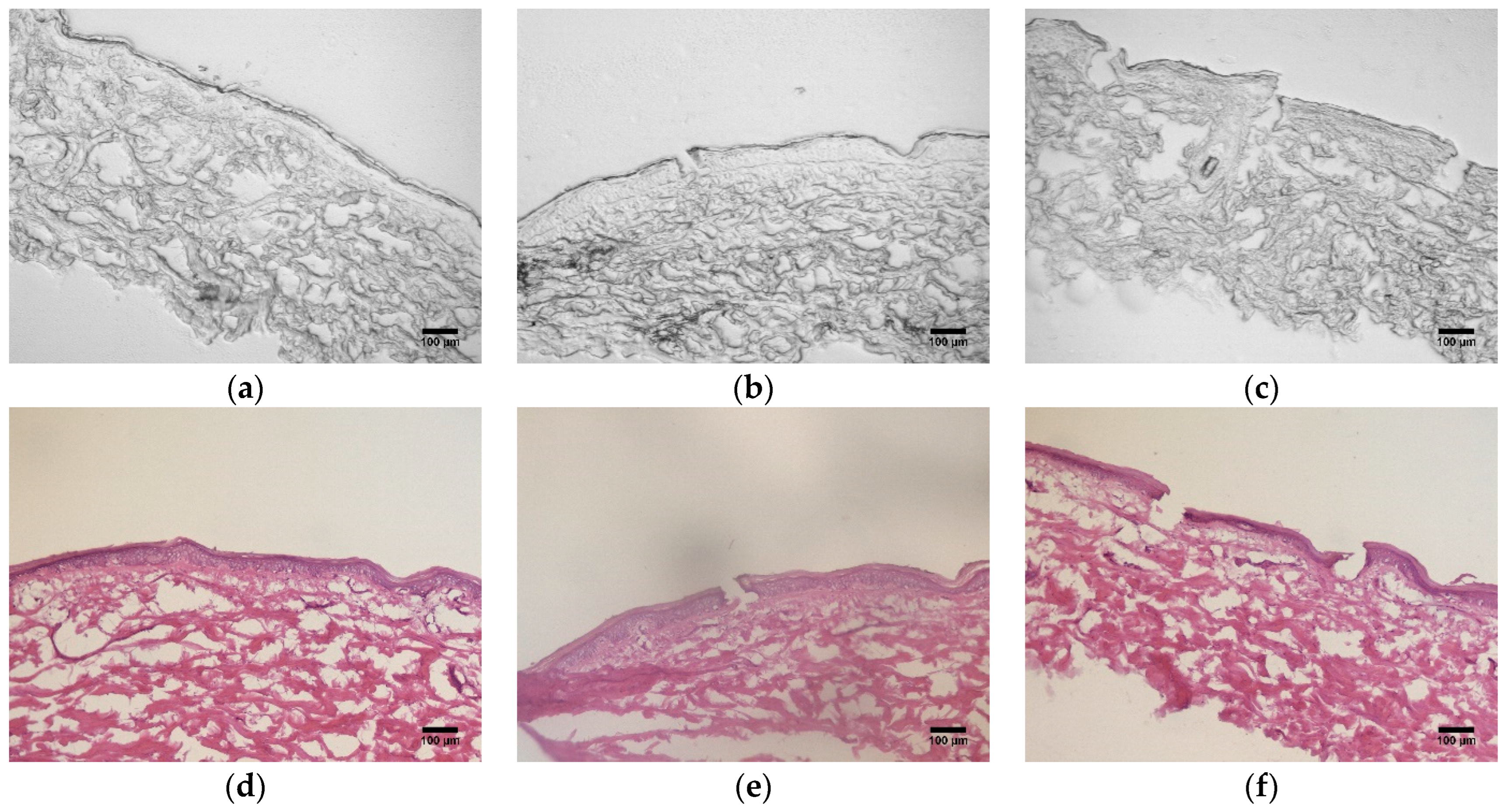
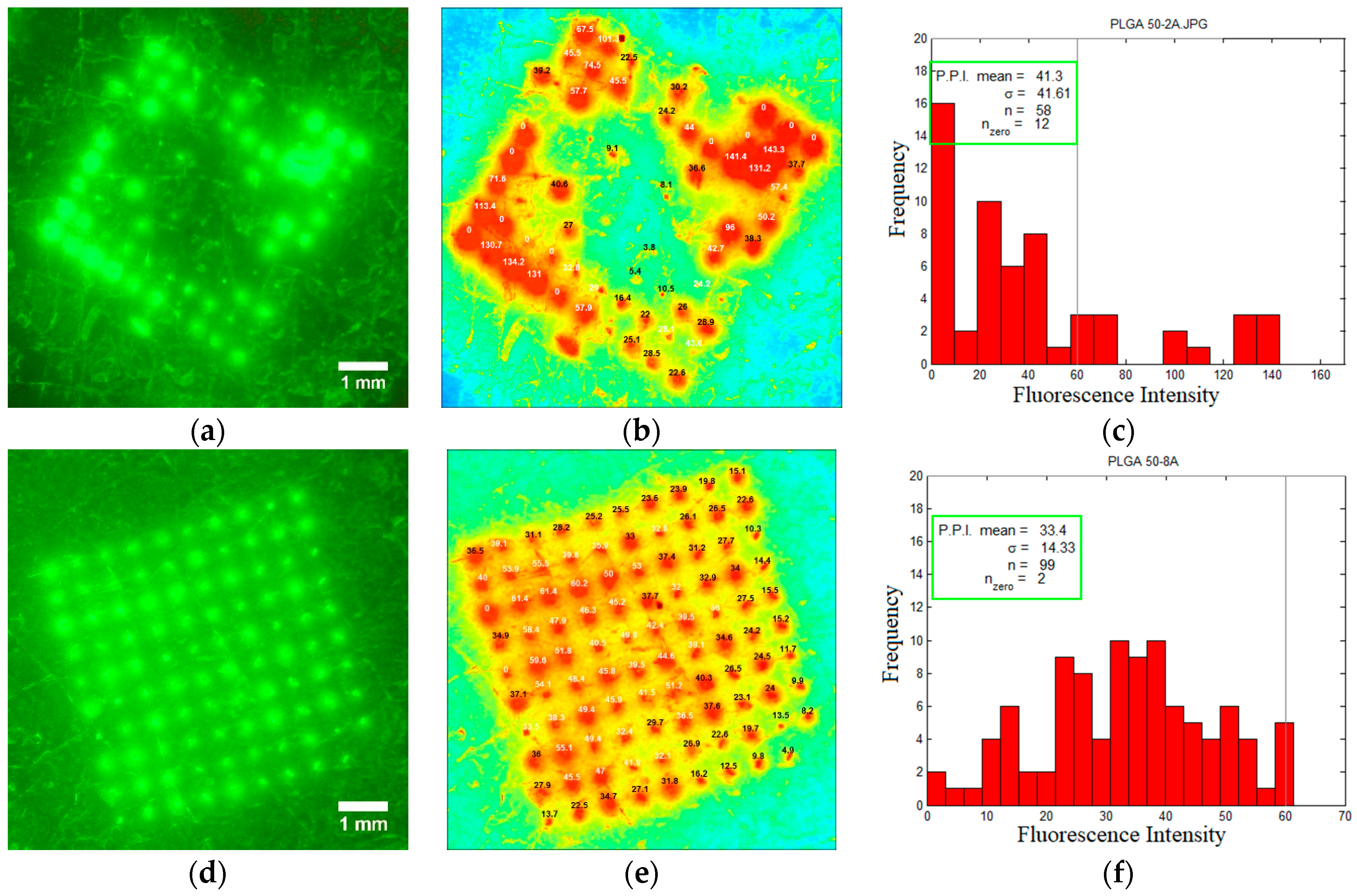
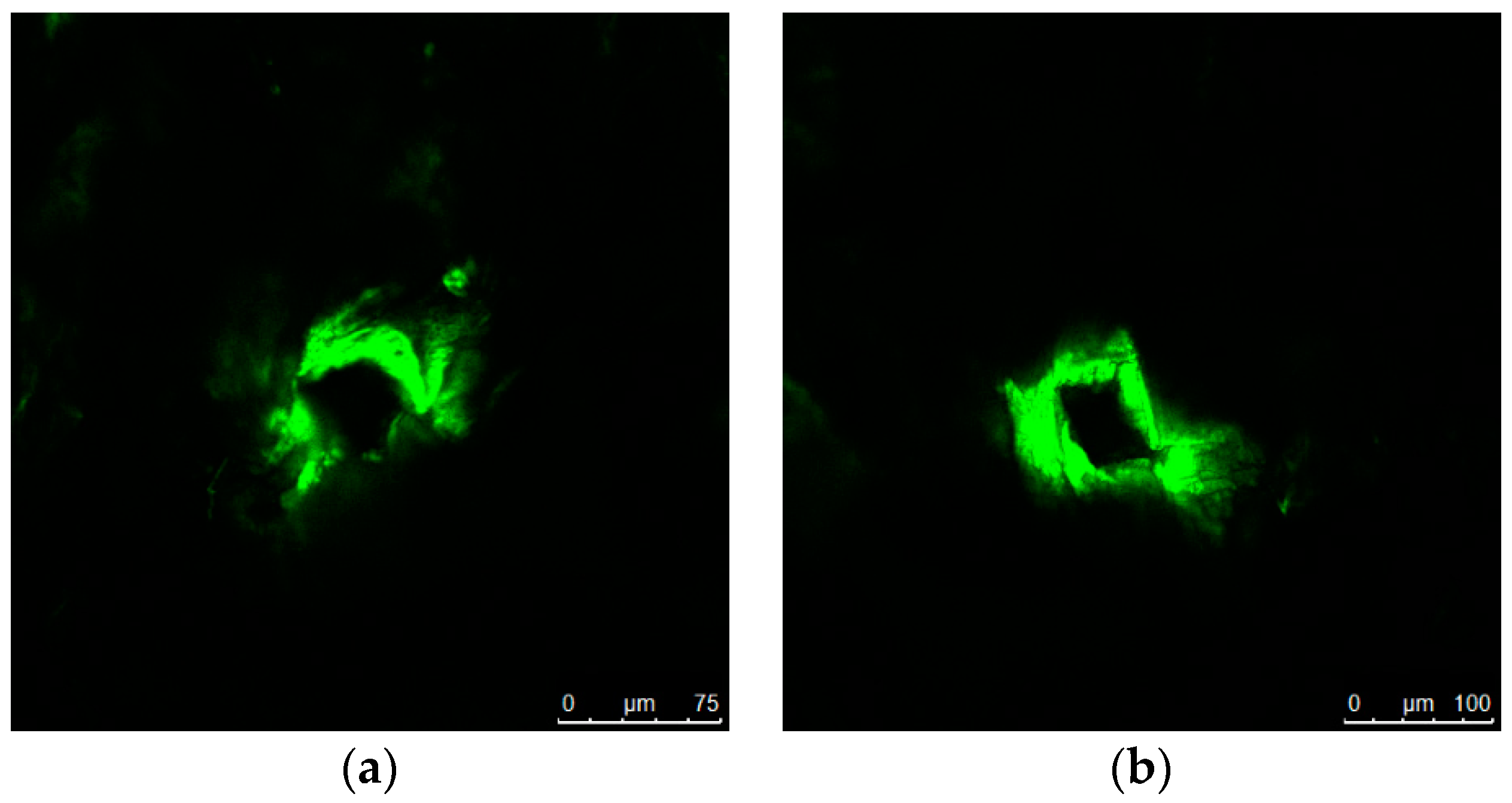
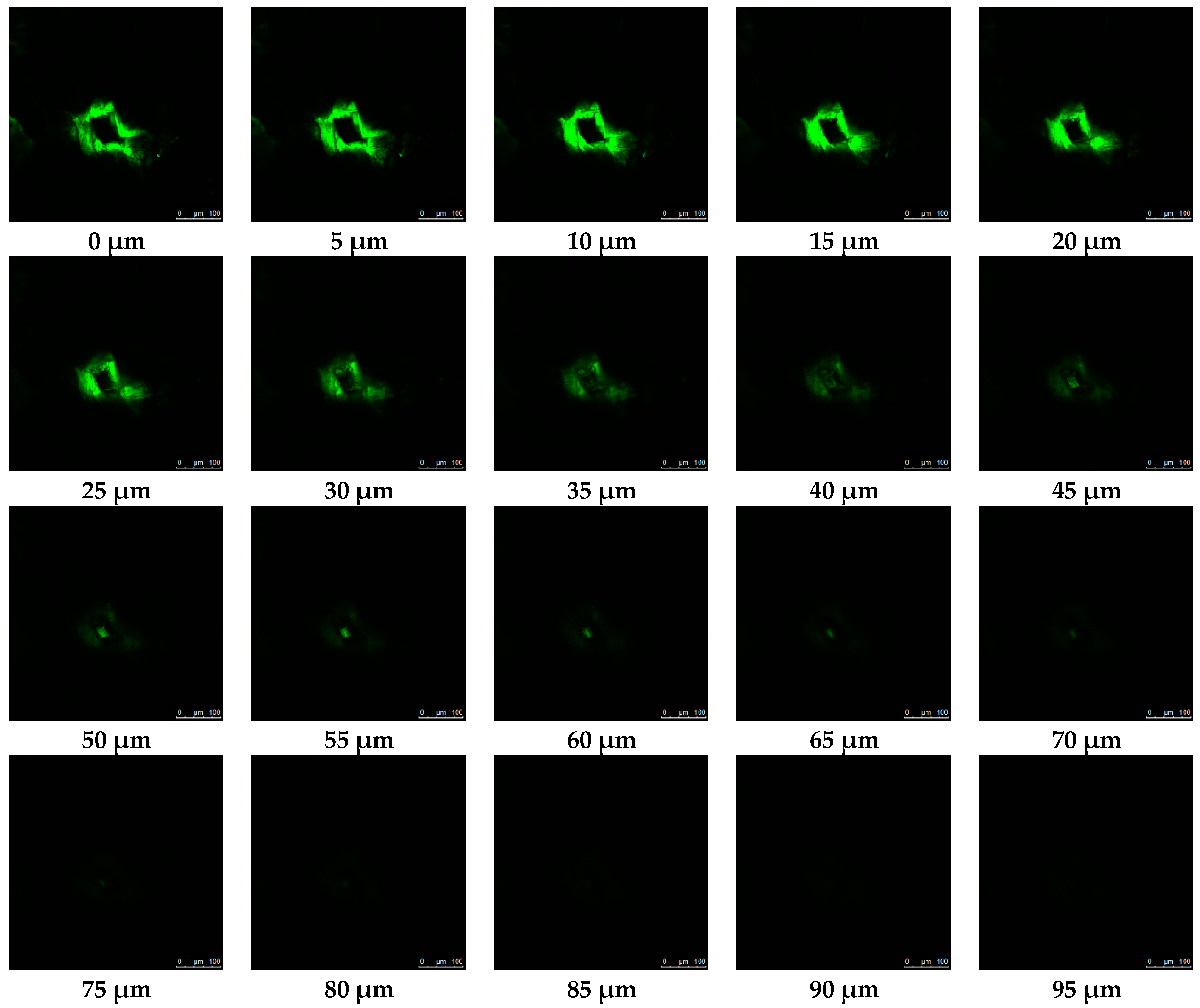



| Microneedles | Needle Length (µm) | Needle-to-Needle Distance (µm) | Base Side (µm) | Tip Diameter (µm) | Pore Area in Skin (sq·µm) | Pore Depth (µm) |
|---|---|---|---|---|---|---|
| PLGA 50-2A | 393.46 ± 74.89 | 518.36 ± 8.30 | 162.20 ± 6.88 | 21.62 ± 17.98 | NA a | NA a |
| PLGA 50-8A | 449.82 ± 9.94 | 516.63 ± 6.39 | 164.03 ± 4.73 | 3.66 ± 1.09 | NA a | NA a |
| Treated PLGA 50-2A | 161.77 ± 65.94 | 516.92 ± 11.64 | 163.88 ± 11.99 | 104.61 ± 32.24 | 8567.11 ± 1812.77 | 74.00 ± 23.90 |
| Treated PLGA 50-8A | 446.54 ± 7.11 | 515.30 ± 10.02 | 162.08 ± 9.36 | 16.65 ±2.19 | 9267.40 ± 3519.77 | 99.00 ± 7.75 |
| Group | Q24 a (µg/sq·cm) | Tlag b (h) | Jss c (µg/sq·cm/h) | D d × 10−5 (sq·cm/h) | Kp e × 10−4 (cm/h) | Css f (µg/L) | Total Delivery g (µg/sq·cm) | Delivery Efficiency h (%) | Topical Selectivity i (%) |
|---|---|---|---|---|---|---|---|---|---|
| Untreated | 0.00 ± 0.00 | NA j | 0.00 ± 0.00 | NAj | 0.00 ± 0.00 | 0.00 ± 0.00 | 2.53 ± 0.48 | 2.53 ± 0.48 | 100.00 ± 0.00 |
| Base-treated | 0.00 ± 0.00 | NA j | 0.00 ± 0.00 | NAj | 0.00 ± 0.00 | 0.00 ± 0.00 | 2.60 ± 0.45 | 2.60 ± 0.45 | 100.00 ± 0.00 |
| PLGA 50-2A | 6.13 ± 1.61 | 4.16 ± 0.74 | 0.34 ± 0.05 | 3.88 ± 0.66 | 3.40 ± 0.49 | 311.58 ± 45.23 | 9.44 ± 1.59 | 9.44 ± 1.59 | 35.86 ± 7.37 |
| PLGA 50-8A | 39.25 ± 10.89 | 1.33 ± 0.42 | 1.69 ± 0.50 | 11.85 ± 4.55 | 16.90 ± 5.04 | 988.92 ± 294.85 | 44.15 ± 10.62 | 44.15 ± 10.62 | 11.60 ± 3.36 |
Disclaimer/Publisher’s Note: The statements, opinions and data contained in all publications are solely those of the individual author(s) and contributor(s) and not of MDPI and/or the editor(s). MDPI and/or the editor(s) disclaim responsibility for any injury to people or property resulting from any ideas, methods, instructions or products referred to in the content. |
© 2024 by the authors. Licensee MDPI, Basel, Switzerland. This article is an open access article distributed under the terms and conditions of the Creative Commons Attribution (CC BY) license (https://creativecommons.org/licenses/by/4.0/).
Share and Cite
Nguyen, H.X.; Kipping, T.; Banga, A.K. Polymeric Microneedles Enhance Transdermal Delivery of Therapeutics. Pharmaceutics 2024, 16, 845. https://doi.org/10.3390/pharmaceutics16070845
Nguyen HX, Kipping T, Banga AK. Polymeric Microneedles Enhance Transdermal Delivery of Therapeutics. Pharmaceutics. 2024; 16(7):845. https://doi.org/10.3390/pharmaceutics16070845
Chicago/Turabian StyleNguyen, Hiep X., Thomas Kipping, and Ajay K. Banga. 2024. "Polymeric Microneedles Enhance Transdermal Delivery of Therapeutics" Pharmaceutics 16, no. 7: 845. https://doi.org/10.3390/pharmaceutics16070845





